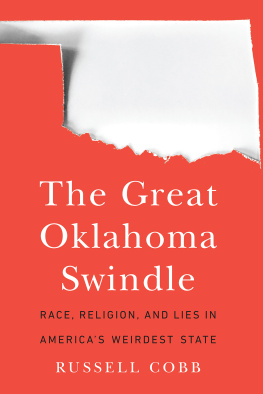


Published by The History Press
Charleston, SC
www.historypress.com
Copyright 2019 by Jonita Mullins
All rights reserved
Cover photographs, authors collection.
E-Book year 2019
First published 2019
ISBN 978.1.43966.748.4
Library of Congress Control Number: 2019937040
print edition ISBN 978.1.46714.352.3
Notice: The information in this book is true and complete to the best of our knowledge. It is offered without guarantee on the part of the author or The History Press. The author and The History Press disclaim all liability in connection with the use of this book.
All rights reserved. No part of this book may be reproduced or transmitted in any form whatsoever without prior written permission from the publisher except in the case of brief quotations embodied in critical articles and reviews.
CONTENTS
INTRODUCTION
The history of the Twin Territorieswhich became the state of Oklahomais peopled with fascinating characters. For many who came here, this place was the end of a difficult and tragic trail. For others, it was a place of new beginnings in a land of opportunity. Whatever their reason for coming to this heartland of America, the people of early Oklahoma were a colorful crew who left an indelible mark on the landscapes and streetscapes of the state.
Sometimes called the most American state because of its beautiful diversity of land and people, Oklahoma was settled unlike any other colony or territory. From the forced removal of many native nations and slaves to land runs to outlaws on the run to the migration of state blacks looking for opportunity, an array of interesting, colorful and courageous people made Oklahoma their home for a short time or for a lifetime. Here are eighty-four brief biographies of some of those individuals who shaped the state and gave it the unique character and culture it is known for today.
CHAPTER 1
THE EXPLORERS
FORT GIBSON OFFICER EXPLORED THE GREAT AMERICAN WEST
Benjamin Bonneville was born in France in 1796. With his mother and younger brother, he immigrated to America in 1803. His father, Nicolas de Bonneville, was a publisher in France who spoke out for a democratic government. He was jailed for his political views and could not accompany his family to the young United States. But his friendship with Thomas Paine and the Marquis de Lafayette helped his family settle in their new home.
At age seventeen, Benjamin entered the Military Academy at West Point; it is likely that Thomas Paine assisted him in gaining admittance to the school. Bonneville graduated in 1815 as a second lieutenant, and as most new West Point graduates, he was sent to the frontier as one of his early assignments. He served at Fort Smith at a location known as Belle Point in Arkansas Territory.
At Fort Smith, Bonneville was assigned to the Seventh Infantry under Colonel Matthew Arbuckle. In 1824, the government decided to build a fort farther west at a location known as the Three Forks where the Arkansas, Verdigris and Neosho (Grand) Rivers meet. Bonneville was aboard one of the keelboats that brought the first supplies to Cantonment Gibson. He remained at the fort until 1825, when he was given a special assignment.
The renowned Marquis de Lafayette, a hero from the American Revolution, was visiting America, and he requested the young lieutenant accompany him on his tour as his clerk. Lafayette and Bonneville made state visits to former presidents Jefferson, Monroe and Madison and also to the current president, John Quincy Adams. Benjamin even returned to France with Lafayette and spent about ten months there before returning to Fort Gibson in 1826.
Bonneville found Fort Gibson much busier than when he had left, and the stockade had been completed. With the Indian removals expected to become official government policy under President-elect Andrew Jackson, the fort was becoming the center of activities relating to the removals. Bonneville attended a meeting with the Cherokee Council at the home of Chief John Jolly. He also helped survey the road from Fort Smith to Fort Gibson, which would become an important supply route and one part of the Trail of Tears.
Now a captain in the military, Benjamin Bonneville had a keen interest in the exploration of the American West, still shrouded in mystery and myth. Bonneville accompanied several expeditions through western Oklahoma, identifying unknown species of flora and fauna and documenting the tribes of the Plains. Later, from 1832 to 1835, Bonneville took a leave of absence from Fort Gibson and explored even farther west. He brought back an authentic study of the geography of the region that included the Great Salt Lake of present-day Utah and the presence of oil in Wyoming.

The Bonneville House still stands near downtown in Fort Smith, Arkansas. Author collection.
Bonneville turned his study of the American West into a book titled The Adventures of Captain Bonneville. Its geographic detail and reliable maps made it a resource for early pioneers striking out to settle the vast reaches of America. His book also created the image of the Mountain Man, an American icon of the early West.
Bonneville returned in 1836 to the army at Fort Gibson, where several companies of Dragoons were now stationed. He remained at Gibson until 1839 but continued in the army for many years, achieving the rank of general. His final assignment was commander of Jefferson Barracks in Missouri. He retired to live in St. Louis and was buried at the Bellefontaine Cemetery there in 1862. His widow built a home in Fort Smith after his death, and it still stands today.
WASHINGTON IRVING IMMORTALIZED THE PRAIRIES OF OKLAHOMA
In 1832, Congress created a commission to assist in the relocation and settlement of the Five Civilized Tribes in Indian Territory. This commission chose Fort Gibson as its headquarters, it being the westernmost U.S. outpost at that time and located in the heart of the lands being set aside for the Indians.
The commission was also given the task of making treaties with the Plains Tribes who roamed the western sections of the territory following the annual migration of the buffalo. Until this time, many of these tribes had made no treaty with the United States and had had little contact with American settlement.
Three men were appointed to the commission: Montfort Stokes, Reverend John Schermerhorn and Henry Ellsworth of Hartford, Connecticut. Congress put at their disposal the Mounted Ranger Company under the command of Captain Jesse Bean, who would be stationed at Fort Gibson.
Captain Bean arrived at Fort Gibson in September 1832 and was shortly ordered to undertake an exploration of the western regions of the newly established Indian Territory. His mission was to try to make initial contact with the Plains Tribes such as the Comanches and Pawnees.
In the meantime, Henry Ellsworth was traveling westward from Connecticut. Onboard a steamship on Lake Erie, Ellsworth met the famous author Washington Irving, who was interested in touring the West. Ellsworth invited Irving to come along with him to Fort Gibson, and Irving jumped at the opportunity. They continued by steamship down the Ohio River to the Mississippi River and then up to St. Louis, where they visited the Chouteaus, a French family of fur traders, and William Clark of the Lewis and Clark Expedition.
Next page






